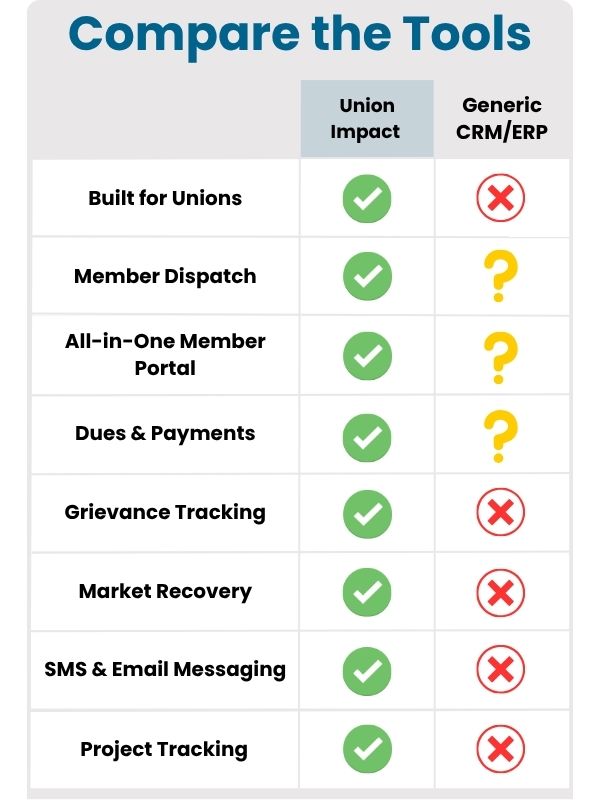Turning Member Data Into Bargaining Power:
Practical ways to use data to mobilize, win contracts, and grow power.
Most locals already collect information—sign‑in sheets, notes from one‑on‑ones, steward logs, bargaining surveys. The challenge is turning that raw data into decisions: where to focus, who to develop, and what actions will move your campaign.
Why data matters (and what it’s not)
Data isn’t surveillance; it’s a map. When members opt in and know why you’re tracking something, you can spot momentum early, fix gaps faster, and bring more people into leadership.

The 7 metrics that help improve bargaining power
1) Member Journey Completion
What it is: The share of new members who complete a simple onboarding path (e.g., welcome call → steward intro → training → first action).
Why it matters: Early experiences predict long‑term engagement.
How to measure: Define 3–5 stages. Track completions within 60–90 days of joining.
Pitfall to avoid: Ten‑step checklists. Keep it short and achievable.
2) Engagement Score (Opt‑in)
What it is: A simple point system for activities members choose to log (attending a meeting, taking a role, speaking to a coworker, etc.).
Why it matters: Identifies rising leaders and issues momentum.
How to measure: 1 point = attendance; 2 = volunteering; 3 = leading. Review weekly.
Pitfall to avoid: Using it punitively. Scores are for coaching, not calling people out.
3) Steward Program Health
What it is: Coverage and responsiveness—ratio of members to active stewards, average time to first reply, and resolution rate.
Why it matters: Stewards are your front line; healthy programs increase trust and participation.
How to measure: Member:Steward ratio target (e.g., 20:1), under‑24‑hour first response, monthly resolution trend.
Pitfall to avoid: Counting titles, not activity. “Active” = taking cases, recruiting, reporting back.
4) Issue Pipeline (from survey to action)
What it is: How many issues are identified, researched, escalated, and resolved each month.
Why it matters: Keeps campaigns moving and prevents “survey fatigue.”
How to measure: A kanban‑style board: Identified → Mapped → Action planned → Action taken → Win or escalate.
Pitfall to avoid: Logging issues with no next step. Every card needs an owner and date.

Our platform is hosted only in SOC 2 Type II / SOC 3 Type II–audited data centers, giving you a proven compliance baseline from day one.
Nightly Off-Site Backups
Your data is backed up automatically every night to a separate, secure data center—so you’re protected from accidental loss or hardware failures.
Security You Can Trust
Your connection to our system is encrypted with HTTPS (SSL/TLS) using 2048-bit certificates, ensuring your data stays private and tamper-resistant in transit.
5) Action Conversion Rate
What it is: Of members contacted for an action, what percent take part? Track by site, shift, and messenger.
Why it matters: Reveals which messages and messengers work—and where to build relationships.
How to measure: Contacts made vs. commitments kept for each action.
Pitfall to avoid: Counting clicks as commitments. Confirm with a yes and a plan (“See you at 12:10 outside Gate B”).
6) Bargaining Campaign Momentum
What it is: Leading indicators before proposals move—pledge cards signed, sticker days, petitions, photo walls, speak‑outs.
Why it matters: Bargaining leverage comes from visible unity, not just good arguments.
How to measure: Weekly counts and participation rate (% of unit). Note which actions are visible to management.
Pitfall to avoid: One‑off stunts. Momentum depends on cadence—small wins building to big shows of power.

Dedicated Infrastructure: Your security is our priority. Every client receives their own dedicated server, meaning your data is never co-mingled with anyone else’s. This private environment ensures maximum security and performance.
Choose a reliable partner that follows the latest security protocols.
7) Organizing Reach into Non‑members
What it is: Conversations, assessments (A–E), and movement through the organizing ladder (supporter → activist → leader).
Why it matters: Growth is power—at the table and in politics.
How to measure: Track initial contacts, assessments, follow‑ups kept, and leadership steps taken.
Pitfall to avoid: Treating assessments as labels. They’re snapshots; coach to move people up.
Privacy & trust: the non‑negotiables
Opt‑in and purpose: Tell members what you’re tracking and why; make opting out easy.
Minimum viable data: Collect only what helps you organize.
Access controls: Limit who sees identifiable info; share roll‑ups widely.
Data rights: Members can see or delete their data on request.
Tool choice: Spreadsheets are fine; if you use apps, ensure encryption and exportability.
A simple weekly cadence
-
Monday (15 min): Update dashboards (or a single shared sheet).
-
Midweek (30 min): Steward huddle—spot hot shops, pick a test action.
-
Friday (15 min): Log outcomes. What moved? What stalled? What’s next week’s action?

Data Sovereignty Guaranteed: We are a U.S.-based company and store all American client data on servers within the United States.

To meet Canadian privacy laws: all Canadian client data is hosted exclusively in Canadian data centers.

For nearly two decades, we’ve been a trusted partner to union halls across North America.
Since 2006, our hands-on experience has given us a deep understanding of the unique challenges you face. We are proud to provide powerful, tailored solutions that solve those challenges and make a real impact on your operations.
Starter Templates (copy/paste into a sheet)
| Metric | Owner | Target | This Week | Trend | Notes / Next Step |
|---|---|---|---|---|---|
| Onboarding completion (≤90 days) | Org lead | 75% | 62% | ↗︎ | Welcome calls lagging on night shift |
| Steward coverage (members per active steward) | Chief steward | ≤20:1 | 28:1 | ↘︎ | Recruit 2 stewards in Packaging |
| Action conversion (Sticker day) | Shift captains | 60% | 47% | → | Switch messengers on A shift |
| Bargaining momentum (pledges signed) | Contract team | 70% | 64% | ↗︎ | Photo wall next Wednesday |
| Non‑member organizing (assessments) | Volunteer team | 25/week | 18 | ↗︎ | Add Saturday house visits |

Union Impact was founded on one principle: unions deserve software designed for them—not retrofitted business tools. By handling migration, integrating core modules, and focusing on compliance and transparency, Union Impact gives locals the tools to stay organized, retain members, and grow.
To hear directly from locals using our platform, see Union Client Testimonials.






